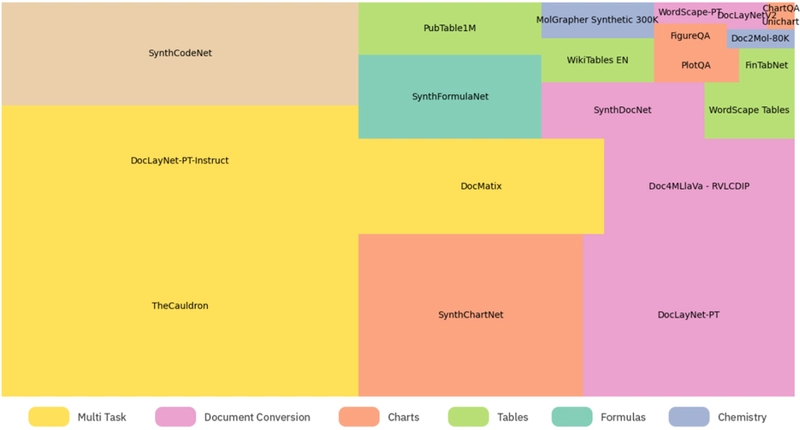Using Docling “Figure Export” capacities.
Introduction
Among the export set of functionality implemented in Docling sets of toolings, the figure export is a very nice one. Using this capacity the user can export content of a PDF file to image format.
Implementation
The usage is quite straightforward, it works on regular Intel laptops, for sure a MacBook M2 or M3 is ideal (overheating 🔥 problems on intel).
# environment settings and preparation
python3.11 -m venv myenv
source myenv/bin/activate
pip install --upgrade pip
pip install docling_core
pip install docling
The input file sample I provided ‘locally’ could be found here: https://arxiv.org/pdf/2503.11576 (SmolDocling: An ultra-compact vision-language model for end-to-end multi-modal document conversion).
import logging
import time
from pathlib import Path
from docling_core.types.doc import ImageRefMode, PictureItem, TableItem
from docling.datamodel.base_models import FigureElement, InputFormat, Table
from docling.datamodel.pipeline_options import PdfPipelineOptions
from docling.document_converter import DocumentConverter, PdfFormatOption
_log = logging.getLogger(__name__)
IMAGE_RESOLUTION_SCALE = 2.0
def main():
logging.basicConfig(level=logging.INFO)
input_doc_path = Path("./input/2503.11576v1.pdf")
output_dir = Path("scratch")
# Important: For operating with page images, we must keep them, otherwise the DocumentConverter
# will destroy them for cleaning up memory.
# This is done by setting PdfPipelineOptions.images_scale, which also defines the scale of images.
# scale=1 correspond of a standard 72 DPI image
# The PdfPipelineOptions.generate_* are the selectors for the document elements which will be enriched
# with the image field
pipeline_options = PdfPipelineOptions()
pipeline_options.images_scale = IMAGE_RESOLUTION_SCALE
pipeline_options.generate_page_images = True
pipeline_options.generate_picture_images = True
doc_converter = DocumentConverter(
format_options={
InputFormat.PDF: PdfFormatOption(pipeline_options=pipeline_options)
}
)
start_time = time.time()
conv_res = doc_converter.convert(input_doc_path)
output_dir.mkdir(parents=True, exist_ok=True)
doc_filename = conv_res.input.file.stem
# Save page images
for page_no, page in conv_res.document.pages.items():
page_no = page.page_no
page_image_filename = output_dir / f"{doc_filename}-{page_no}.png"
with page_image_filename.open("wb") as fp:
page.image.pil_image.save(fp, format="PNG")
# Save images of figures and tables
table_counter = 0
picture_counter = 0
for element, _level in conv_res.document.iterate_items():
if isinstance(element, TableItem):
table_counter += 1
element_image_filename = (
output_dir / f"{doc_filename}-table-{table_counter}.png"
)
with element_image_filename.open("wb") as fp:
element.get_image(conv_res.document).save(fp, "PNG")
if isinstance(element, PictureItem):
picture_counter += 1
element_image_filename = (
output_dir / f"{doc_filename}-picture-{picture_counter}.png"
)
with element_image_filename.open("wb") as fp:
element.get_image(conv_res.document).save(fp, "PNG")
# Save markdown with embedded pictures
md_filename = output_dir / f"{doc_filename}-with-images.md"
conv_res.document.save_as_markdown(md_filename, image_mode=ImageRefMode.EMBEDDED)
# Save markdown with externally referenced pictures
md_filename = output_dir / f"{doc_filename}-with-image-refs.md"
conv_res.document.save_as_markdown(md_filename, image_mode=ImageRefMode.REFERENCED)
# Save HTML with externally referenced pictures
html_filename = output_dir / f"{doc_filename}-with-image-refs.html"
conv_res.document.save_as_html(html_filename, image_mode=ImageRefMode.REFERENCED)
end_time = time.time() - start_time
_log.info(f"Document converted and figures exported in {end_time:.2f} seconds.")
if __name__ == "__main__":
main()
The output is perfect for usage.
It is quite easy to use a nice user interface by Streamlit or TKinter for instance but I just focused on the core functionality.
Conclusion
“Figure Export” is a very interesting feature, among others, provided by open source Docling tool. The implementation is fast and easy.
Links
Docling: https://github.com/docling-project?q=&type=all&language=&sort=
Docling documentation: (https://docling-project.github.io/docling/)
Appendix
Docling current Features
🗂️ Parsing of multiple document formats incl. PDF, DOCX, XLSX, HTML, images, and more
📑 Advanced PDF understanding incl. page layout, reading order, table structure, code, formulas, image classification, and more
🧬 Unified, expressive DoclingDocument representation format
↪️ Various export formats and options, including Markdown, HTML, and lossless JSON
🔒 Local execution capabilities for sensitive data and air-gapped environments
🤖 Plug-and-play integrations incl. LangChain, LlamaIndex, Crew AI & Haystack for agentic AI
🔍 Extensive OCR support for scanned PDFs and images
🥚 Support of Visual Language Models (SmolDocling) 🆕
💻 Simple and convenient CLI




